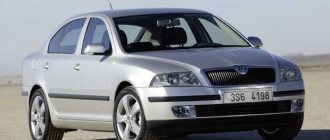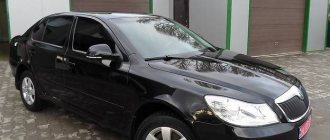The Skoda Rapid appeared on the menu of the automaker from Mladá Boleslav in 2012. The model arrived in Russia in 2014, where it was assembled - near Kaluga.
The liftback replaced the budget version of the Octavia Tour, occupying a separate niche. Thanks to this, Skoda received more freedom in pricing, without a negative impact on the image and sales of Octavia.
The model is based on the enlarged PQ25 platform. For many, the Rapid may be a good alternative to the older second-generation Octavia. The Rapid is a little simpler in design, and uses harder plastic in the interior, which is noticeable to the naked eye.
The Skoda Rapid, in comparison with the Octavia 2, is not much inferior in terms of functionality, and has enough space for rear passengers and luggage. The owner has at his disposal a 550-liter trunk, a number of practical hooks and a net for securing small items. Competitors are not able to offer such a spacious and functional hold. The presence of a liftback body means easy access to the luggage compartment. For Europeans, the model is available in one more body option – Spaceback. In essence, this is a classic five-door hatchback.
The Skoda Rapid is based on the concern's popular and time-tested technologies, which are still too early to go to the landfill. This has a positive effect on operating costs in the long term. Despite the advanced age of some of the solutions, the Rapid handles well and clearly. This was achieved using a small trick. The rear axle has a wider track, which improves directional stability and helps in cornering.
Comfort: ★★★★☆
The Skoda Rapid has good driving performance, however, it is inferior to some of its competitors in its ability to filter out bumps. The same is true for chassis sound insulation, while engine noise and aerodynamic noise are not very noticeable.
Some perceive the Rapid as another version of the Fabia. However, Rapid is more spacious. It provides 9cm more rear legroom and is 4cm wider inside.
Economical
This is a big disadvantage of the Skoda Rapid, since it does not use low fuel consumption. In the city it consumes about 12 liters per 100 kilometers, given its fairly small 1.6-liter engine. On the highway, of course, everything is better: about 8 liters per 100 kilometers. We were talking about a naturally aspirated engine. If you take a modification with a turbo engine, the efficiency will be better and the consumption will be less.
As mentioned above in the article, the 1.4 liter TSI is very good, its service life is high, and its efficiency is good. However, there is a small drawback: in city driving or in a traffic jam, you need to press the gas pedal with your little finger. After all, one small press - the car will rush out of its place. And this is not the most important thing; reviews of the shortcomings of the Skoda Rapid say that its transmission is very slow and constantly malfunctions. Therefore, once again it is better not to accelerate, so as not to make her nervous, and constantly change gears. However, once you get off the ground, the Skoda Rapid is fun to drive. There were no reviews from owners about the shortcomings of the Skoda Rapid on the topic of acceleration: the car does it quickly and without shifting the gearbox.
Engines: ★★★★☆
Until 2021, the base was a three-cylinder 1.2 HTP power unit with 75 hp. Considering that the Rapid is not too heavy, its potential is quite enough for calm drivers who are not demanding on dynamics and do not intend to load their car to capacity.
Much more interesting is the 1.2 TSI with power from 86 to 105 hp. (rare in Russia). The engine is flexible and provides good dynamics, while consuming not much more fuel than a three-cylinder naturally aspirated one.
The most powerful in the model’s arsenal is the petrol 1.4 TSI with an output of 122 hp, which is combined only with an automated DSG gearbox.
Well, the most reliable option was the popular 1.6-liter naturally aspirated MPI, developing 90, 105 or 110 hp.
Rapid, like Volkswagen models, experienced problems with engines, especially those installed before restyling in 2015. First of all, this applies to the 1.2 and 1.4 TSI EA111 series, i.e. those that have a timing chain drive. It happened that it stretched even during the first 20,000 km (30,000 rubles with work). After restyling, engines of the new EA211 series with a timing belt instead of a chain became available.
The Rapid received an improved version of the naturally aspirated 1.2 MPI. True, it sometimes causes problems with the ignition system. In addition, owners had to deal with premature stretching of the timing chain.
From 2021, the three-cylinder 1.0 TSI began to be offered in Europe. We haven't heard of any problems with it yet. True, its life expectancy is a big question, since the established oil change interval is 30,000 km.
In addition, Europeans have access to a diesel version with the 1.6 TDI in two power options – 90 and 105 hp. His weaknesses are well known, but they are not many. For example, the exhaust gas recirculation valve is rented out. The second typical problem is failure of the turbine geometry changing system. There are also problems with injectors, but they are usually eliminated by updating the software.
In Russia, atmospheric 1.6 is most widespread. Until 2015, a unit with the code designation CFNA was installed. It developed 105 hp. and had a timing chain drive. The engine was widely used in the Volkswagen Polo Sedan, where it became famous for the knocking of the pistons. The problem did not spare Rapid either. Fortunately, the disease usually does not progress and is not a reason for urgent major repairs.
Another drawback is cracking of the exhaust manifold after 80-100 thousand km. You will have to pay 6,000 rubles for a new collector.
After 2015, they began to install 1.6 with the CWVB index with a return of 90 hp. and CWVA - 110 hp. Both engines received a timing belt drive with a recommended replacement interval of 120,000 km. The cost of spare parts and labor will be about 15,000 rubles.
Many owners complain about the oil consumption of 1.6 liter engines - from 0.5 to 1 liter between changes.
Skoda Rapid engines – When there is nothing to choose from
1.2 MPI – Why?
The 3-cylinder 12-valve 1.2 MPI (CGPC) engine that Rapid inherited from Fabia initially evoked enthusiastic exclamations from the owners. Well, of course, because consumption of 4.5 liters on the highway at current prices for the 95th pleasantly warms the pocket.
But 75 horses with 1200 kg of car weight with a frail driver at the wheel is like arriving at the dacha at the same time as a neighbor who won’t let his “penny” slip out of his hands, even if you were driving a race. If, in addition to the driver, 3 more passengers sit in the cabin, filling the trunk with zucchini, then the claimed acceleration to 100 in 14 seconds becomes nothing more than a colorful fairy tale.
The inability to properly carry out the assigned task for the 1.2 MPI engine also adversely affected the resource. The piston engine lasts about 250 tkm without major repairs. But that is not all. The “eternity” of the timing chain also turned out to be short-lived. After 100 thousand mileage, there are frequent cases of chain slipping with all the ensuing consequences (bent valves, crumbled pistons, broken cylinder head).
1.6 MPI – native “informers” and “oil-guzzlers”
The first thing that Rapid users noticed was that about the car’s appetites and, it turns out, even with a manual transmission on the highway it is impossible to meet the declared 4.9 l/100 km. The maximum that can be achieved is 7 l/100km outside the city and 9.5 l/100km in the city.
Very often, owners confuse knocking when cold with the noisy operation of hydraulic compensators, but the culprit in most cases is the CFNA piston
However, fuel consumption is not the worst thing. Most of all, Skoda Rapid owners are afraid of the CFNA feature, which manifests itself even during the warranty period. The same knock of pistons that once bothered the owners of the VW Polo Sedan. For those who noticed strange sounds during warm-up in time, the pistons were changed under warranty, the rest considered this normal and sometimes drove 300 tkm without adding oil or losing traction. But not everyone went smoothly. There have been cases when scuffing on the cylinders led to loss of compression and, accordingly, to “capital” at 100 tkm, which is pitiful by modern standards.
As you tap, the piston skirts scratch the cylinder bore
You cure one thing, you cripple another.
With a mileage of about 100 thousand km, or even earlier, many owners note significant oil consumption. Contacts with officials established that the engine design itself contains an appetite of about 400 grams per 1000 kilometers. The well-fed Kulibins, in an attempt to sort out the situation, set about disassembling the unit and found that it was not so much the design that was to blame for the oil burn, but rather the “curly” assembly. “It’s necessary to place the piston ring locks on top of each other,” servicemen share their impressions. However, this opened our eyes to why some people’s engine “eats”, some don’t, some have little, some have half a liter per thousand.
Needless to say, rapid drivers need to be very careful about the oil level in the 1.6 CWVA engine. Moreover, every 50 tkm it is recommended to decoke the combustion chamber, since the burnt lubricant is deposited in a hard layer on the pistons and not only, increasing the engine’s ability to detonate, which, as we know, most skillfully “kills” the engine.
A common problem with 1.6 engines on Rapid is the knocking sound of the left engine mount when driving over bumps. Dealers are well aware of this and unquestioningly change the pillow under warranty.
1.4 TSI - a classic from VAG
The 122-horsepower turbocharged 1.4 TSI engine with the index EA211 is one of the best Volkswagen engines in terms of economy and efficiency, and it’s hard to disagree with this. But in this review of used Rapid we are interested in reliability.
In general, the more complex turbocharged unit turned out to be no more harmful than its opponents in the Skoda Rapid engine compartment. In the first versions of the engine, due to a defective tensioner, the timing chain stretched prematurely and “jumps” occurred with the destruction of pistons and rings, bending of valves, and breakdown of phase change clutches. Malfunctions related to the operation of the pump and direct injection system were not uncommon. In general, savings and efficiency sometimes cost some (not all, of course) owners thousands of dollars in repairs, at the same time significantly tarnishing the reputation of the VAG concern.
Like all direct injection petrol turbo units, the 1.4 TSI requires a special approach to maintenance. It is better to reduce the period between replacement of consumables by half of that specified by the manufacturer, and then the turbine will be able to last a respectable 150 tkm.
The modernized 1.4 TSI (125 hp), which is now installed on the Rapid, has an aluminum cylinder block lined with cast iron. The chain was replaced by a belt, which calmly, without incident, takes care of 60-90 thousand. Pump leaks still occur during early runs.
The “first oil” from turbocharging in the intake appears quite early - at 50-60 thousand. With proper care, the turbine travels about 150 tkm
As befits petrol turbo units, the 1.4 TSI oil “eats”, but relatively little – approximately 400 grams from replacement to replacement. Looking at the excellent traction abilities and moderate appetites, the choice in favor of 1.4 becomes obvious. True, if you take into account that this power unit, together with the near-TOP equipment, will cost you around 800 thousand rubles, there won’t be many people who want to treat themselves to a “turbine”.
Gearbox: ★★★★☆
Depending on the version, the Rapid was equipped with a 5-speed manual transmission, a 6-speed automatic transmission or a 7-speed DSG robot.
During the initial period of production, there were complaints about the manual transmission. Bearings wore out, gears were knocked out, and difficulties arose with engaging gears.
The automatic transmission does not cause serious complaints if the transmission fluid is regularly updated. However, a number of owners have encountered a malfunction of the gear selector due to a microswitch failure (100 rubles).
Those who buy a car with DSG should keep in mind that it can withstand about 150-200 thousand km. But first, after 100-150 thousand km, you have to change the clutch. The cost of a new set is about 30,000 rubles. Together with the flywheel you will have to fork out 70,000 rubles.
Specifications
The Skoda Rapid has one engine, the shortcomings and disadvantages of which cannot be counted. This is a 1.2 liter petrol engine, which has always been installed on the Phabia model and has again been installed on the Rapid model. It was inappropriate: the car was heavy and the engine was weak. Not a single owner of this modification of the Czech brand recommends it. He's too bad for her. Overtaking in a car with this engine will make things worse for yourself. This is one of the disadvantages of the Skoda Rapid automatic.
But the 105th 1.6-liter engine is noticeably more powerful, and not only that. It is much more convenient to accelerate, control your speed, and overtake. Still, it is much faster than its 1.2-liter brother. Therefore, there are few shortcomings of the Skoda Rapid 1.6. Also available with this engine is a manual gearbox, which works no less well than the engine itself. However, there is one small drawback: on the highway there is not enough sixth gear, as well as more horsepower, in order to confidently accelerate to more than 150 kilometers per hour. However, this car was clearly not created for racers. It is worth noting that for fans of fast driving, turbocharged Skoda Rapid engines can easily be chip-tuned. It will add an extra 20-30 horsepower, and you will be able to enjoy the power that was sorely lacking.
Handling and chassis: ★★★★☆
Although the Rapid is not the best in its class in terms of handling, it is quite docile and predictable. MacPherson struts are installed on the front axle, and an elastic beam is installed on the rear axle. On cars from the initial production period, the rear shock absorbers could make noise (about 4,000 rubles per pair). After restyling in 2015, the deficiency was eliminated. The suspension and brakes are quite strong, and in case of repairs the prices will be quite attractive.
The struts and bushings of the anti-roll bar usually have to be replaced after 40-80 thousand km. After 50-100 thousand km, the front shock absorbers are sold out (from 1,700 rubles for an analogue), and the rear ones, as a rule, need to be replaced no earlier than 100,000 km (from 1,000 rubles).
Silent blocks and wheel bearings run over 100-150 thousand km. A little later it’s the turn of the ball joints.
Engine life 1.4 TSI
The naturally aspirated 1.4 TSI engine paired with a manual gearbox is by far the most popular modification. The turbocharged version can rightfully be called a top-end assembly. The four-cylinder power unit operates via a timing chain, which has a good service life. The manufacturer recommends replacing it after a mileage of 70-80 thousand kilometers. Despite the fact that the timing chain was initially positioned as a “perpetual mechanism,” practice has shown that sometimes it fails even before the allotted time. Therefore, it is recommended to replace it earlier if the car is used in difficult conditions.
The manufacturer assures that a Skoda Rapid with a 1.4-liter engine under the hood will cover at least 250-300 thousand kilometers. There are serious reasons to trust this information. The fact is that this power unit has shown impressive reliability since the time it was installed on Volkswagen cars. The new E211 units, which replaced the EA111 series motors, are distinguished by a cast iron block, an aluminum head, lightweight pistons and a reinforced crankshaft. Improved technical characteristics allow the owner of the Skoda Rapid to count on trouble-free operation of the car up to the first 300 thousand km.
Operating costs: ★★★★☆
Simple and time-tested technology and economical engines guarantee reasonable operating costs. Simple solutions are less labor-intensive to maintain, and the cost of spare parts and repairs is in most cases lower than that of the Octavia.
The list of shortcomings is modest. There is no need to complain about corrosion protection. The only thing that can rust is the muffler. There are no problems with the paintwork either. Cases of water accumulation in the spare wheel well are random.
After a while, cracks in the paintwork applied to the sealant can be found on the trunk lid (along the inner edges) and in the trunk opening (at the junction of the roof and pillars). Paintwork defects are also observed in the area of the wheel arches - the coating on the inner edge of the wing is peeling off.
Sometimes the gas tank flap stops opening. A faulty actuator is to blame for this - 1200 rubles.
Mention should be made of malfunctions of the gas pedal position sensor, as well as occasional malfunctions in the operation of the airbag control module and seat belt pretensioners.
Sometimes the buttons on the steering wheel and on the head unit begin to malfunction. The malaise is eliminated with the help of new firmware (about 2,500 rubles). On cars produced in 2021, with the arrival of cold weather, the Swing3 multimedia screens began to burst. Authorized services replaced the defective device within the warranty.
Failure of the air conditioning compressor clutch also occurs. Official services updated the compressor assembly, the cost of which was 26,000 rubles. Unauthorized services have mastered the technique of replacing the coupling (about 7,000 rubles).
It happens that the heater fan starts beeping in the first minutes after starting. Cleaning the fan from dust and dirt allows you to get rid of noise.
The servomotor of the air conditioning mixing damper may also fail (7,400 rubles). Either warm or cold air begins to blow from the deflectors.
How long does a Skoda Rapid engine last according to reviews from car owners?
About what the real consumption of the Skoda Rapid engine actually is, reviews of owners who have been convinced from their own experience of the high duration of stable operation of the main unit will be more informative.
1.4TSI
- Pavel, Moscow. I am the former owner of a Skoda Rapid 1.4 l. It just so happened that I recently had to say goodbye to the car. In general, it left behind a good impression - a comfortable and practical body, low fuel consumption, and, of course, a long service life. It is not difficult to find components, and many of them fit VG cars. Personally, I drove the car about 80 thousand km during all this time, I did not notice any problems or “jambs” in the assembly. There are also no complaints about the chassis, it holds the road vigorously.
- Alexey, Saratov. I don’t drive too much; I’ve clocked up 120 thousand kilometers in four years. Replaced the chain, a labor-intensive process, but worth it. Moreover, it was replaced at the turn of the first hundred thousand, although the car did not give any signals. The 1.4 engine is peppy and energetic, this volume and power is quite enough for comfortable daily movement around the city. Service is inexpensive and so are the parts. I expect to drive the car at least 250 thousand km to the capital.
- Mikhail, Rostov. I purchased a new car in 2012. When I first started using the car I noticed the pistons were knocking. I went to the service center, they quickly fixed everything. The Czechs have known about this for a long time; supposedly, the problem was solved back in 2013. I don’t know how things are with the pistons on new assemblies. Today the mileage is 180 thousand kilometers. During this time, I changed the timing chain once, which is much more reliable than a belt. Once replaced, you can drive another hundred thousand kilometers. I use imported motor oil. If you use certified fuel and lubricants, the engine will cover 300 thousand km without problems.
- Kirill. Moscow. Great machine, no complaints. Definitely worth the money. I do not recommend spoiling the firmware; it may affect the overall service life of the Skoda Rapid engine. It eats little, maintenance and components are inexpensive. In three years I have already accumulated 90 thousand kilometers. The chassis is excellent, the ground clearance is just right for our roads. The build quality is no worse than many models from VG, and in some cases even better.
Owners of the Skoda Rapid 1.4 TSI note the modification’s high performance properties, reliability and long engine life. The life of the chain is 90-100 thousand kilometers, which is longer than the period stated by the manufacturer. This car can cover 200-250 thousand km without any problems.
1.6MPI
- Vasily, St. Petersburg. From my own experience I can say that the service life of the engine depends 30% on the quality of fuel and lubricants, and 70% on driving style. I maintain a calm manner, so my Rapid, after four years of use, has never seriously broken down. Like everyone else, I underwent scheduled maintenance, changed consumables and the timing chain. It is also important to refuel with good fuel, fill in imported oil and have it serviced only by an OD.
- Sergey, Voronezh. I will say this - I am dissatisfied with the car. When the 150 thousand kilometer mark was reached, literally everything began to break down. The new pistons are clearly unfinished; it was necessary to spend a lot of money on replacing parts of the piston group. I've been using the Skoda Rapid for five years, and just recently sold the car. In return, I received frayed nerves, sleepless nights and a lot of wasted money.
- Albert, Vladivostok. Initially I thought of purchasing the version with a turbocharged engine, but at the last moment I changed my mind. I purchased a 2013 Skoda Rapid 1.6 l with a manual transmission. I like everything about the car: from assembly to design. One friend works as a taxi driver on a turbocharged Rapid, his mileage has already exceeded 300 thousand, however, the turbine needs additional care. I'm currently at 120 thousand km.
- Vladislav, Khabarovsk. I have a 2021 car with an upgraded 1.6-liter engine. I don’t know if I came across a bad assembly, or if the Czechs simply forgot how to assemble cars. The reliability of the new naturally aspirated engine has clearly dropped, and the new pistons are to blame for this! The timing belt is now quieter, but it is unsuitable for repair, plus it breaks the engine oil every time. I am not sure that this unit will exhaust at least the resource built into it, let alone produce beyond the norm.
Skoda Rapid 1.6 received different ratings from drivers. Mostly owners of cars produced in 2013-2014 speak positively about the car. Owners of the new version have so far noted some design flaws, which the manufacturer may eliminate in the future. In general, this version of the car covers 250-300 thousand kilometers without problems or breakdowns.
Childhood diseases Skoda Rapid (2012 – present).
The name Rapid is not new for the Skoda brand. It was invented back in the mid-30s. Last mentioned in '84, it was a small two-door coupe designed by Giorgetto Giugiaro. Returning to the origins of model names is a tradition for Skoda.
2012, Mlada - Boleslav (Czech Republic), production of a new liftback model began (there is also a SpaceBack version - a regular hatchback) - Skoda Rapid. After 2 years, assembly began at the Kaluga plant.
Engines: 1.6 l (from 90 to 110 hp, acceleration to 100 km/h - 10.3 sec, average consumption - 5.8 l/100km), 1.2 l (85 - 105 hp, up to 100 km - 10.3 sec, mixed consumption - 5.4 liters), 1.4 (125 hp, up to 100 km - 9 seconds, city/highway consumption - 5.3 liters) and two diesel engines for Europe 1.4 (90 hp), 1.6 (90-116 hp) .
Transmissions: manual – 5 speed, torque converter automatic – 6 gears and DSG 7 (only for 1.4).
The Rapid is built on the basis of the Polo Sedan, but is 12 cm longer than its brother. The suspension is rigid, the ground clearance is 170 mm (just right for Russia), 5 - euroNcup stars, the interior plastic is hard but of high quality.
In the basic configuration: ABS, exchange rate control system, driver airbag, central locking, electric. power steering, front windows, daytime running lights, on-board computer, washer fluid indicator).
Maximum configuration options: climate control, 6 airbags, hill climb assist, sports front seats and steering wheel, keyless entry, light and rain sensor, cruise control, 4 power windows, bi-xenon headlights, rear view camera, heated seats and windshield glass, Amudsen navigation system with AUX/USB/Bluetooth, alloy wheels 16 radius, driver fatigue sensor, parking sensors, central armrest.
Children's sores of Skoda Rapid or what to look for before buying a used one?
| Sores | Solutions |
| Engine | |
| hum of the air conditioning compressor produced by the company - Sanden | the problem was solved in 2021 by installing a compressor from Denso |
| increased oil consumption 1.6 (110 hp) CWVA | do not pour Castrol oil, change the brand (for example, Liqui Moly 8977/9077), change the oil every 7,500 - 10,000 km (depending on the operating mode, city/highway) |
| Electrics | |
| The accelerator pedal oxidizes, stops responding to pressure, and the Check Engine lights up | The pedal assembly was replaced due to the recall campaign (a rare problem, but it costs free to replace) |
| Body | |
| water accumulation in rear doors | remove the door seals, clean the drainage holes, trim the seal at the holes |
| Salon | |
| The speakers wheeze at sub-zero temperatures, the speaker diffusers freeze, after warming up the interior the problem goes away | replace with modified ones or supply non-original ones, the manufacturer replaces the speakers under warranty (since December 2014, modernized ones are installed) |
| the code and chrome on the gearshift knob are peeling off | replacement under warranty or installation of an updated handle |
| The side support of the driver's seat is wiped (to the metal base) | replace under warranty or repair |
Other problems with the car can be viewed at VW Polo Sedan. In the article about Polo, you need to pay attention to: hydraulic compensators, pump, rack, gearbox mount, stabilizer bushings, heater fan, knocking of pistons in the 1.6 CFNA engine - I did not find such a problem on the Rapids (assembled in the Russian Federation - 2014, engines were installed "cured")
There is still little information about turbo versions, but since 2013 they have become belt driven, and all the problems of previous modifications have been eliminated (we were lucky with the engines!). The latest generation DSG-7 (since 2014) is installed on the Rapid, no “old” problems were noticed, but do not forget that in this box it is advisable to change the oil every 50,000 km.
Skoda Rapid was able to avoid many hereditary diseases. This was to be expected; it began to be produced later (while the older brother was knocking the pistons). Compared to Polo: Rapid is larger, more practical, more interesting and reliable. It's definitely worth paying attention to.
See you soon!
Did you like the article? Share it!











